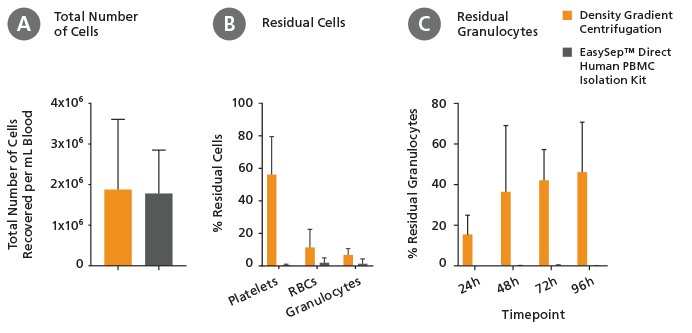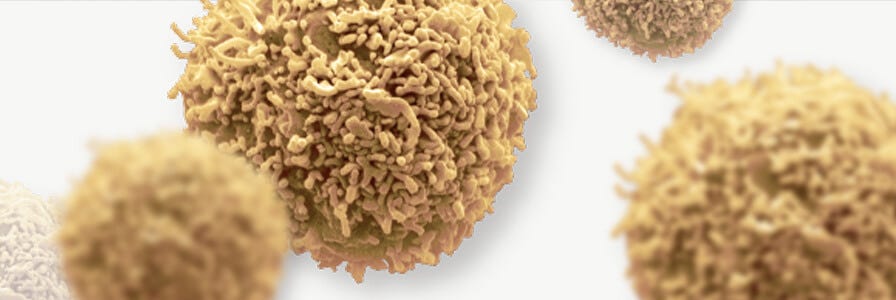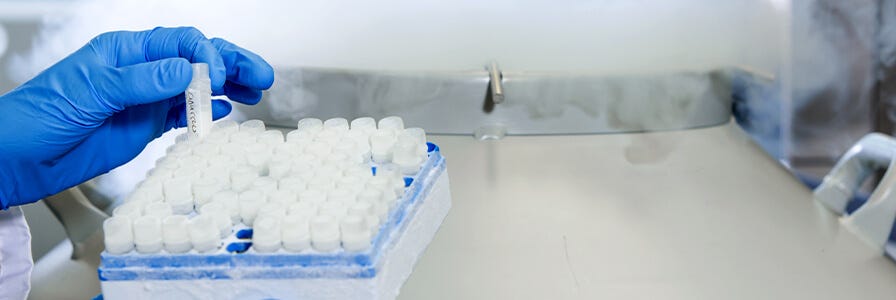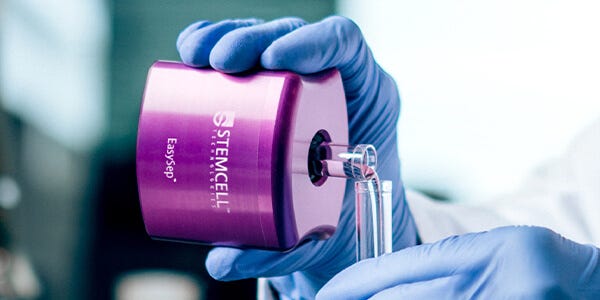Peripheral Blood Mononuclear Cells: Isolation, Freezing, Thawing, and Sourcing
Researchers collect human peripheral blood mononuclear cells (PBMCs) from blood samples for use in various research applications, including flow cytometry, cell isolation, cell culture, and cell-based assays. Learn more about PBMCs and find protocols and tools to help you isolate, source, freeze, and thaw human PBMCs for your research.
PBMC Composition
PBMCs include lymphocytes (i.e. T cells, B cells, and NK cells), monocytes, and dendritic cells, and are defined as white blood cells with round nuclei. Preparation of a PBMC fraction from whole blood is a common step prior to the isolation of specific immune cell subsets.
Frequencies of Cell Types in Human Peripheral Blood
Get a list of the estimated frequencies and percentages of more than 25 cell types in normal human peripheral blood.
Preparing and Isolating PBMCs from Whole Blood
There are several methods for collecting and preparing PBMCs from human whole blood, each with its own advantages and disadvantages. Learn about three methods below.
Basic PBMC Isolation Protocol Using Density Gradient Centrifugation
The most common PBMC isolation method involves using a density gradient medium (e.g. Ficoll™ or Lymphoprep™) and centrifugation. This method takes advantage of the differences in density between the cells in blood and the density gradient medium.
How to Isolate Mononuclear Cells from Whole Blood by Density Gradient Centrifugation
To isolate mononuclear cells from human peripheral blood, cord blood, and bone marrow, it is recommended to use a medium with a density of 1.077 g/mL, such as Lymphoprep™.
Advantages to using density gradient centrifugation to isolate PBMCs include the low cost of the density gradient media, lack of specialized equipment, and ease of introduction to any lab. However, this protocol is time-consuming, laborious, and cannot be automated. Isolating PBMCs from one sample can take at least 45 minutes.
Faster Density Gradient Centrifugation Using SepMate™ PBMC Isolation Tubes
SepMate™ is an innovative tube that enables consistent and hassle-free PBMC isolation in a 15-minute protocol. SepMate™ simplifies the density gradient centrifugation protocol, resulting in fewer errors and reduced variability between users. You can quickly layer blood over the density gradient medium because the SepMate™ insert prevents the layers from mixing. Centrifugation is performed for only 10 minutes with the brake on, after which isolated PBMCs are simply poured off into a fresh tube and washed.
SepMate™: Hassle-Free PBMC Isolation Protocol
See how SepMate™ works and request a sample to try it in your own lab.
Isolation of Highly Purified PBMCs Using Magnetic Cell Separation
Skip centrifugation and isolate PBMCs directly from blood in as little as 20 minutes using EasySep™ Direct Human PBMC Isolation Kit. This kit immunomagnetically depletes red blood cells (RBCs), platelets, and unwanted cells in a single step without density gradient centrifugation. Untouched PBMCs are simply poured into a new tube and are immediately available for downstream applications such as flow cytometry or cell culture.
EasySep™ Direct Human PBMC Isolation Kit
See how EasySep™ Direct magnetic cell separation works and learn more about the EasySep™ Direct Human PBMC Isolation Kit.
How does EasySep™ Direct PBMC isolation compare to density gradient centrifugation?
1. Reduces platelet contamination
Density gradient centrifugation doesn’t remove platelets, which can easily become activated. Removing platelets requires additional time-consuming washing steps after the initial density gradient centrifugation. The EasySep™ Direct Human PBMC Isolation Kit removes platelets during cell isolation (see Figure 1).
2. Reduces granulocyte contamination
Granulocytes in blood samples degranulate and change density over time. Processing older blood samples (>48 hours after collection) using density gradient centrifugation may result in granulocyte contamination. By specifically targeting unwanted cells for removal with antibody complexes and magnetic particles, the EasySep™ Direct Human PBMC Isolation Kit results in reduced granulocyte contamination compared to density gradient centrifugation (see Figure 1).
3. Enables automated PBMC isolation
EasySep™ Direct Human PBMC Isolation can be automated using the RoboSep™-S instrument to minimize sample handling and free up valuable hands-on time. By automating all sample labeling and magnetic separation steps you can perform simultaneous cell isolations from up to 4 samples and increase sample throughput.
Learn more about RoboSep™ cell separation instruments >

Figure 1. EasySep™ Direct Human PBMC Isolation Kit Results in Fewer Contaminating Cells Compared to Density Gradient Centrifugation
Compared to Density Gradient Centrifugation Mononuclear cells were isolated from whole blood samples using either density gradient centrifugation or EasySep™ Direct Human PBMC Isolation Kit. Cells were counted and analyzed by flow cytometry. (A) Both density gradient centrifugation and EasySep™ Direct Human PBMC Isolation Kit resulted in an equivalent total number of nucleated cells recovered from 24-hour blood samples (mean ± SD; n=14). (B) Using EasySep™ Direct Human PBMC Isolation Kit to obtain mononuclear cells from 24-hour old blood samples resulted in lower numbers of residual platelets (CD41+), red blood cells (Glycophorin A+/CD45-), and granulocytes (CD66b+) compared to density gradient centrifugation (mean ± SD; n=15). (C) Cell isolation from 24-hour, 48-hour, 72-hour and 96-hour old blood samples using EasySep™ Direct Human PBMC Isolation Kit resulted in lower numbers of residual granulocytes compared to cell isolation using density gradient centrifugation (mean ± SD; n=3).
Try the EasySep Direct Human PBMC Isolation Kit in your own lab.
Sourcing Fresh or Frozen Human PBMCs
Laboratories looking for a reliable supply of mononuclear cells can source human PBMCs from primary cell suppliers. Large lots of cryopreserved PBMCs with specific donor criteria (e.g. sex, age range, BMI range, ethnicity, CMV status, HLA type, diseases, etc.) can be secured, thereby ensuring consistency across multiple experiments.
Alternatively, researchers can obtain blood products such as leukopaks and Leukocyte Reduction System (LRS) cones, which contain large numbers of mononuclear cells collected from human peripheral blood. Learn how to process leukopaks and LRS cones for the isolation of mononuclear cells:
- Protocol: Processing a Leukopak for Downstream Cell Isolation
- Video: How to Recover Cells from a Leukocyte Reduction System (LRS) Cone
Partner with the Right Human Primary Cell Supplier
See how we can work with you to find human primary cells that are ethically sourced, approved for use in your application, and customized to meet your specific needs.
Learn More >Frequently Asked Questions on Primary Cells
Find answers to frequently asked questions on primary cells from STEMCELL Technologies, including donor information, validation, and delivery options.
Learn More >Contact our primary cells team to learn more about how we can help you meet your research goals with fresh or frozen human primary cells.
Freezing and Thawing Human PBMCs
Researchers working with human cells can store frozen vials of isolated PBMCs for use in future assays (e.g. flow cytometry). To cryopreserve PBMCs, the cells are resuspended in cryopreservation medium, cooled to extremely low temperatures, then stored at liquid nitrogen temperatures (below -135°C) until needed. When the cells are needed, the cryopreserved PBMCs can be thawed and then used in downstream applications.
How to Cryopreserve PBMCs with CryoStor® CS10
Learn how to safely freeze human primary cells in ready-to-use, cGMP-manufactured CryoStor® CS10 for long-term storage.
VWatch Now >How to Thaw Frozen Primary Cells
Learn the proper technique for thawing frozen cells. Ensure optimal viability, recovery, and functionality of your cells for downstream applications.
View Protocol >Ensure high cell viability and functional stability following storage and thawing by using a reliable cryopreservation medium. Explore our cell storage media, including cGMP-manufactured and serum-free CryoStor® Freezing Media.
Downstream Applications: Using PBMCs in Your Research
Researchers use PBMCs for many downstream applications, including further isolation of specific cell subsets (e.g. T cells, B cells, monocytes), cell culture, and assays (e.g. flow cytometry).
Find products and technologies to support your specific downstream applications:









